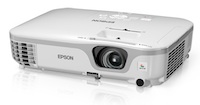Epson Intros 3,000-Lumen Classroom Projector

The PowerLite X15 offers ±30 degree horizontal and ±30 degree automatic vertical keystone correction. |
Epson has debuted a new LCD-based multimedia projector for small to mid-sized classrooms that require flexibility in setup.
The PowerLite X15 is an XGA-resolution (1,024 x 768) projector that offers 3,000 lumens of brightness and a contrast ratio of 3,000:1. With both horizontal and automatic vertical keystone correction and with independent adjustments for each individual corner of the image, the unit is designed for flexibility in placement. It has a throw ratio of 1.48 to 1.77 and can project an image 30 inches to 300 inches in diameter from a distance of 2.9 feet to 35.9 feet.
Other features include:
- Closed captioning support;
- ±30 degree horizontal and ±30 degree automatic vertical keystone correction;
- Support for projecting images and play audio from a Mac OS X or Windows-based system using a USB port;
- 1.2x optical zoom;
- Direct power on/off;
- Integrated 2 watt mono speaker;
- An anchor bar and Kensington lock slot for security; and
- Up to 5,000 hours of lamp life in economy mode (4,000 hours in normal mode);
AV inputs include HDMI, RGB (mini D-sub 15-pin), USB type B (for audio and video), S-video, composite video, and stereo minijack. AV outputs include monitor (mini D-sub 15-pin) and stereo minijack. Communications ports include USB type A for connecting to external storage and other devices (including the Epson DC-06 document camera) and RS-232c.
The unit measures 11.6" (L) x 9" (W) x 3.1" (H) and weighs in at 5.1 pounds.
The PowerLite X15 will be available in May for $599. Additional details can be found on Epson's projector portal or on the company's education portal.